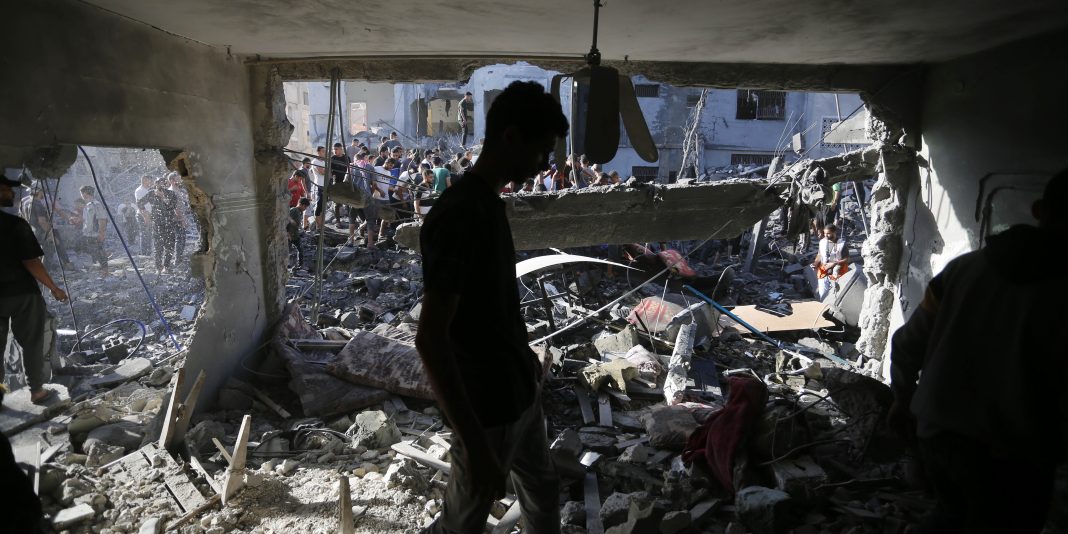In the wake of a year marked by relentless violence and suffering, the narrative of Gaza is one that transcends mere statistics. While numbers can provide a glimpse into the devastation, they often fail to encapsulate the profound emotional and psychological toll on the civilian population. The tragic events that unfolded on October 7, 2023, serve as a stark reminder of the human cost of conflict. On that fateful night, an Israeli airstrike targeted a home in Abasan al-Kabira, resulting in the deaths of 18 family members, including five children and four women. Among the survivors was 11-year-old Tala Abu Daqqa, whose injuries reflect the broader trauma experienced by countless others in Gaza.
Since that day, the situation has only deteriorated. According to the Gaza Ministry of Health, the ongoing Israeli military operations have led to the deaths of nearly 42,000 Palestinians and left over 96,000 injured. Alarmingly, estimates from a group of American health workers suggest that the actual death toll may be three times higher, potentially exceeding 118,000. This staggering figure underscores the urgent need for a reevaluation of the humanitarian crisis unfolding in Gaza.
The implications of this conflict extend beyond immediate fatalities. Researchers have highlighted the indirect consequences of warfare, estimating that for every direct death, there may be four additional deaths attributable to factors such as disease, lack of medical care, and shortages of essential resources. A study published in *The Lancet* posits that the total death toll could reach as high as 186,000, a grim forecast that reflects the ongoing humanitarian catastrophe.
As the death toll rises, so too does the United States’ military support for Israel. In recent months, the Biden administration has approved significant arms sales, including advanced fighter aircraft and munitions, totaling over $20 billion. President Biden has publicly reaffirmed unwavering support for Israel, despite acknowledging potential violations of international law regarding the use of U.S. weapons in Gaza. Advocacy groups have condemned this support, emphasizing the direct link between American arms and the suffering of Palestinian civilians. John Ramming Chappell from the Center for Civilians in Conflict poignantly stated, “Israeli military attacks, often using weapons made in the United States, have leveled countless homes, destroyed schools and hospitals, and made Gaza all but unlivable.”
The physical toll of the conflict is staggering. The World Health Organization reports that a significant portion of the injured population in Gaza will require long-term rehabilitation, with many suffering from life-altering injuries. Between 3,100 and 4,000 limb amputations have been performed, alongside thousands of cases of spinal cord and traumatic brain injuries. The health care system, already weakened by years of blockade, has been further devastated, with nearly 500 attacks on medical facilities reported since the onset of hostilities. The result is a dire situation where critical medical evacuations are routinely denied, leaving patients without necessary care.
The humanitarian crisis extends beyond health care. The United Nations reports that approximately 1.9 million people in Gaza have been displaced, with many facing dire living conditions in overcrowded shelters. The destruction of infrastructure has led to a catastrophic decline in access to clean water and food. Over 2.1 million Palestinians are now facing acute food insecurity, with nearly 745,000 in emergency status and 495,000 at risk of famine. The agricultural sector has been decimated, with significant declines in crop health and livestock populations, exacerbating the already critical food shortages.
The psychological impact of this conflict on the youth of Gaza is particularly alarming. UNICEF estimates that over 1 million children now require mental health support, a staggering figure that reflects the widespread trauma experienced by the youngest members of society. With schools damaged or destroyed, more than 659,000 children have been out of school since the war began, risking the creation of a lost generation. The long-term implications of this educational disruption could reverberate for years to come, hindering the development of an entire population.
The narrative of Gaza is one of profound suffering, marked by loss, trauma, and resilience. The story of Tala Abu Daqqa, a child who has witnessed unimaginable horror, serves as a poignant reminder of the human cost of conflict. While statistics can provide a framework for understanding the scale of destruction, they cannot convey the depth of anguish felt by those who survive. The challenge lies not only in addressing the immediate humanitarian needs but also in recognizing and responding to the long-term psychological and social ramifications of this ongoing crisis.
As the world watches, the people of Gaza continue to endure a reality that defies comprehension. The need for a comprehensive and compassionate response to this humanitarian disaster has never been more urgent. In the face of overwhelming adversity, the resilience of the human spirit shines through, reminding us all of the importance of empathy, understanding, and action in the pursuit of peace and justice.


